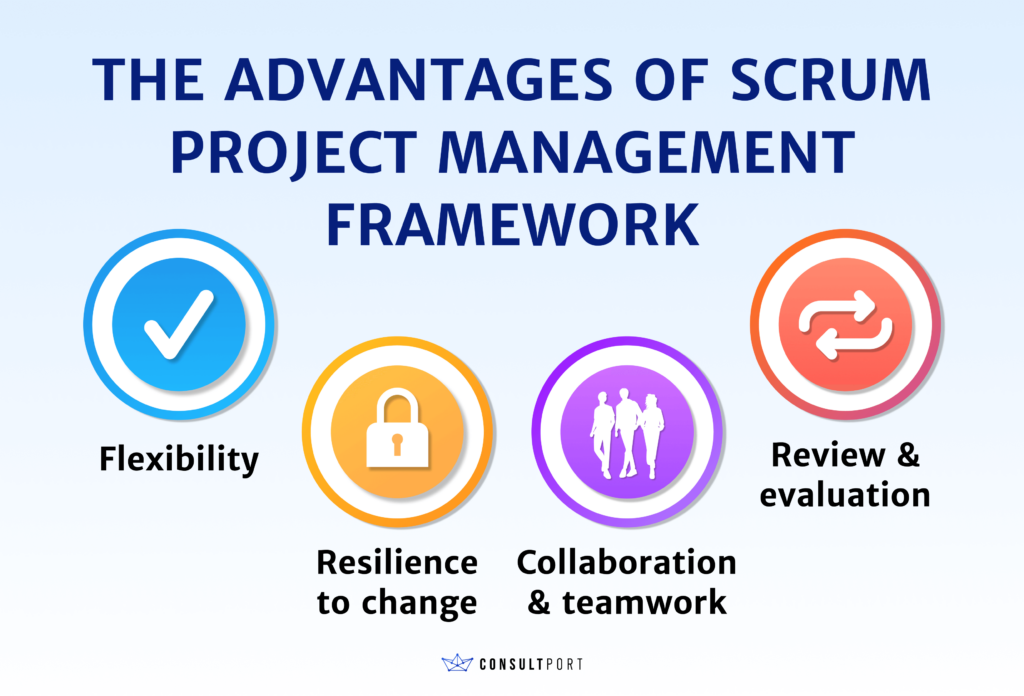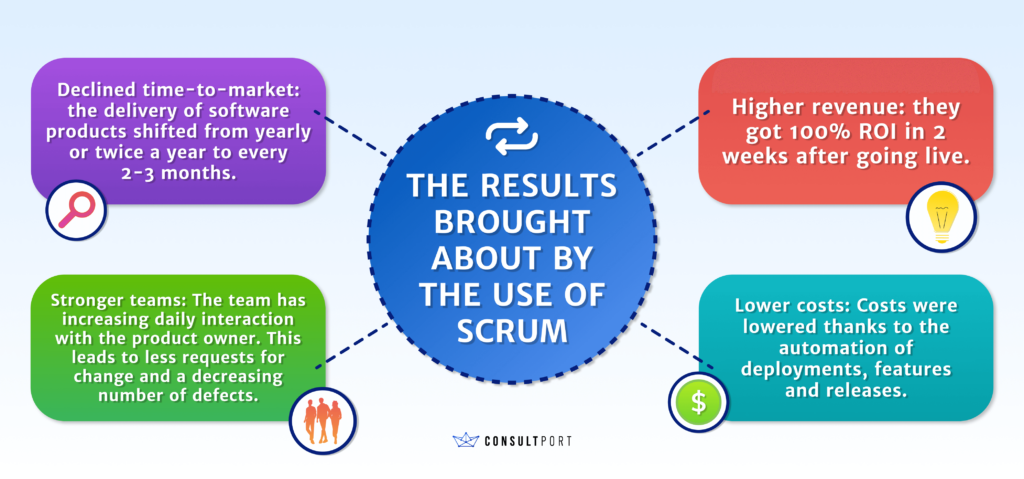Why Scrum Project Management Is So Popular


Share this article

Scrum has been known as one of the world’s most effective frameworks for project management, especially software development projects.
The concept was first fully implemented for software teams at Easel Corporation in 1993 by Jeff Sutherland, John Scumniotales and Jeff McKenna. Forbes even said the framework deserves a Nobel-level recognition in management.
This methodology has garnered huge attention from firms for good reasons. According to TechReport, 66% of Agile businesses use Scrum framework and it has the potential to increase productivity by 300-400%.

In this blog post, Consultport explores how the Scrum project management framework operates. We also dive in its advantages and disadvantages as well as its application beyond software development.
The concept was first fully implemented for software teams at Easel Corporation in 1993 by Jeff Sutherland, John Scumniotales and Jeff McKenna. Forbes even said the framework deserves a Nobel-level recognition in management.
This methodology has garnered huge attention from firms for good reasons. According to TechReport, 66% of Agile businesses use Scrum framework and it has the potential to increase productivity by 300-400%.

In this blog post, Consultport explores how the Scrum project management framework operates. We also dive in its advantages and disadvantages as well as its application beyond software development.
KEY TAKEAWAYS
- In the Scrum project, work is organized in short cycles, the team is independent in deciding time needed, how to do the work in the iteration as well as measuring their own performance.
- Flexibility, adaptability, collaboration, teamwork and continuous review are key advantages of the Scrum project management framework.
- Scrum has gone well beyond software development and is being used widely in marketing, supply chain, manufacturing, among many others.
How Scrum Project Management Works
The Scrum framework involves the management of a complex project through breaking it into many phases. Each phase features a cycle of planning, execution and evaluation.
According to The Scrum Handbook, it is an agile methodology aiming to infuse “energy, focus, clarity and transparency” to the planning and implementation of the project.
The framework was first fully implemented in 1993 at the Easel Corporation by Jeff Sutherland along with John Scumniotales and Jeff McKenna, according to Forbes.
Nowadays the method is used widely in small, medium and large software companies across the world. It is also becoming increasingly popular in other areas such as marketing, finance and academia.
The cycles of work in which Scrum structures the development, are known as sprints. They often last from two to four weeks. At the end of each sprint, the team conducts review and evaluation.
People involved in the process include: product owner, Scrum master (project manager) and a team who implement the tasks, according to Indeed.
The basics of Scrum include:
It specifies a list of what is requested in an order of value to the customer or business.
The Product backlog changes during the project with items added, removed or reprioritized, said the book.
Sprint begins with a planning meeting, where the product owner and team examine the product backlog and discuss the goals for items.
After that, the whole team participates in a daily standup meeting which is about 15 minutes long. There is a presentation of the progress of the project, which can lead to replanning and further discussion, said the handbook.
Once the sprint process finishes, the Scrum team conducts the sprint review meeting, where they and stakeholders examine and discuss what has been done as well as discuss what to do next. According to the handbook, this meeting gathers product owner, team member, scrum master, as well as customers, stakeholders, executives, among others.
Besides the sprint review, the team also gathers for sprint retrospective, where they explore what’s working and what’s not, and suggest changes.
According to The Scrum Handbook, it is an agile methodology aiming to infuse “energy, focus, clarity and transparency” to the planning and implementation of the project.
The framework was first fully implemented in 1993 at the Easel Corporation by Jeff Sutherland along with John Scumniotales and Jeff McKenna, according to Forbes.
Nowadays the method is used widely in small, medium and large software companies across the world. It is also becoming increasingly popular in other areas such as marketing, finance and academia.
The cycles of work in which Scrum structures the development, are known as sprints. They often last from two to four weeks. At the end of each sprint, the team conducts review and evaluation.
People involved in the process include: product owner, Scrum master (project manager) and a team who implement the tasks, according to Indeed.
The basics of Scrum include:
Product backlog
A product vision serves as the foundation for a Scrum project. It is developed by the product owner and expressed in the Product Backlog, according to The Scrum Handbook.It specifies a list of what is requested in an order of value to the customer or business.
The Product backlog changes during the project with items added, removed or reprioritized, said the book.
Sprints
Sprints are the cycles of work that product development is structured. It often lasts 1 to 4 weeks. The date for the end of the sprints is made specific and never extended.Sprint begins with a planning meeting, where the product owner and team examine the product backlog and discuss the goals for items.
After that, the whole team participates in a daily standup meeting which is about 15 minutes long. There is a presentation of the progress of the project, which can lead to replanning and further discussion, said the handbook.
Once the sprint process finishes, the Scrum team conducts the sprint review meeting, where they and stakeholders examine and discuss what has been done as well as discuss what to do next. According to the handbook, this meeting gathers product owner, team member, scrum master, as well as customers, stakeholders, executives, among others.
Besides the sprint review, the team also gathers for sprint retrospective, where they explore what’s working and what’s not, and suggest changes.
Advantages of Scrum Project Management
Scrum is the most widely used and trusted framework of reference in software.
According to The Scrum Handbook, the methodology can bring about a range of improvements if it is implemented properly. They include increasing the speed of development and aligning individual and corporate objectives.
The method also helps firms create a performance-driven culture, support shareholder value creation. Scrum project management also plays an important role in helping companies achieve “stable and consistent” communication of performance at all levels, said the handbook. Now let’s dive deeper into the advantage of this simple yet powerful methodology:
Scrum framework also facilitates flexible prioritization, said Forbes. The methodology allows firms to be flexible in and adaptive to customer-driven features.
Sprints enable them to better manage their shippable units of work and progress towards a final product milestone.
“To get a timely ROI from engineering, their work needs to be shipped and customers need to realize value from those features as early as possible,” Venkat Rangan from Clari Inc told Forbes.

Scrum framework allows firms to be responsive to changes and use it as a competitive advantage to implement the project successfully.
According to research, adaptation is one of the three key pillars of Scrum (along with inspection and transparency). The team can identify faults, make adjustments and reduce the risks of a poor result for the whole project.
In addition, there is no formal hierarchy in the team and they are willing to help each other and all take responsibility for the results. The smooth collaboration leads to the team achieving better results.
Transparency is reflected in the ongoing communication and collaboration in the team as well as clearly defined roles and responsibilities of members. This ensures they are on the same page, and avoid any unnecessary confusion that may affect the project’s productivity.
Meetings which are held on a regular basis, also help the Scrum team obtain feedback on the product and make prompt adjustments.
Therefore, it might be challenging to use the Scrum project management framework for large projects. Those which want to adopt this approach on a big scale need to conduct extensive training and effective coordination.
If the team has more than 10 members, it should be split into sub-teams or mini teams. While this can facilitate collaboration and teamwork, it may be difficult for firms to arrange staff into teams.

In marketing, Scrum helps organizations to organize their campaigns and attract customers from the top of the funnel down toward conversion.
In supply chain optimization, a Scrum approach can be used to break down the work into basic and repeatable pieces with 1-2 week sprints.
Challenge
Before adopting Scrum, the airline company mainly used waterfall development methods for their software product segment. The problem encountered was that it took months or even years to deliver a product or even a single feature to market. The company experienced decreasing market share compared to competitors.
Solution
Upon considering the agile framework, Lola Tech decided that Scrum was its best fit. Scrum is extended and many Scrum teams are instructed on how they work together to deliver an integrated product at least every Sprint cycle.
To address problems, Lola Tech focused on:

According to The Scrum Handbook, the methodology can bring about a range of improvements if it is implemented properly. They include increasing the speed of development and aligning individual and corporate objectives.
The method also helps firms create a performance-driven culture, support shareholder value creation. Scrum project management also plays an important role in helping companies achieve “stable and consistent” communication of performance at all levels, said the handbook. Now let’s dive deeper into the advantage of this simple yet powerful methodology:
Flexibility
According to Indeed, Scrum is suitable for a wide variety of environments and situations that don't initially have clearly identifiable requirements and require a flexible approach.Scrum framework also facilitates flexible prioritization, said Forbes. The methodology allows firms to be flexible in and adaptive to customer-driven features.
Sprints enable them to better manage their shippable units of work and progress towards a final product milestone.
“To get a timely ROI from engineering, their work needs to be shipped and customers need to realize value from those features as early as possible,” Venkat Rangan from Clari Inc told Forbes.

Resilience to change
The changing markets require companies to have prompt responses to the changes in requirements. Scrum project management method is designed to meet the changing requirements of complex projects.Scrum framework allows firms to be responsive to changes and use it as a competitive advantage to implement the project successfully.
According to research, adaptation is one of the three key pillars of Scrum (along with inspection and transparency). The team can identify faults, make adjustments and reduce the risks of a poor result for the whole project.
Collaboration and transparency
Scrum team is a self-organized, self-managed and collaborative unit. Effective communication within the team and with stakeholders results in better results. Once there is a roadblock occurring, the team collaborates to address the problem as quickly as possible.In addition, there is no formal hierarchy in the team and they are willing to help each other and all take responsibility for the results. The smooth collaboration leads to the team achieving better results.
Transparency is reflected in the ongoing communication and collaboration in the team as well as clearly defined roles and responsibilities of members. This ensures they are on the same page, and avoid any unnecessary confusion that may affect the project’s productivity.
Continuous review and evaluation
Every sprint cycle in Scrum finishes with review and evaluation. This allows the firm to understand what’s working and what’s not working as well as explore new ways to deliver value more efficiently.Meetings which are held on a regular basis, also help the Scrum team obtain feedback on the product and make prompt adjustments.
Disadvantages of Scrum Project Management
Despite its great potential, Scrum has its own drawbacks that companies need to be aware ofLimited scope
This is one of the biggest limitations of Scrum. The Scrum process is “linear” and does not allow for much “side-tracking”, according to an article about agile methodology in software development.Therefore, it might be challenging to use the Scrum project management framework for large projects. Those which want to adopt this approach on a big scale need to conduct extensive training and effective coordination.
Small team-orientedness
The Scrum project management framework does not work well with large teams. The process is built for small, agile teams. It is the most suitable for teams of 3 to less than 10. Those that have large teams often work in a well-structured manner. This can slow down the project and affect the overall quality.If the team has more than 10 members, it should be split into sub-teams or mini teams. While this can facilitate collaboration and teamwork, it may be difficult for firms to arrange staff into teams.
Application of Scrum Project Management
Scrum framework has been used widely and beyond the software sector. A recent study showed that 36% of organizations that are having active Scrum projects are using the methodology beyond IT. Scrum can be used in a range of fields: marketing, academia, finance, hardware, among many others.
In marketing, Scrum helps organizations to organize their campaigns and attract customers from the top of the funnel down toward conversion.
In supply chain optimization, a Scrum approach can be used to break down the work into basic and repeatable pieces with 1-2 week sprints.
Case study
Lola Tech, a software company, helped its client, a major US budget airline with over 4,000 employees, to use the Nexus framework to reduce time-to-market, lower costs and increase revenues.Challenge
Before adopting Scrum, the airline company mainly used waterfall development methods for their software product segment. The problem encountered was that it took months or even years to deliver a product or even a single feature to market. The company experienced decreasing market share compared to competitors.
Solution
Upon considering the agile framework, Lola Tech decided that Scrum was its best fit. Scrum is extended and many Scrum teams are instructed on how they work together to deliver an integrated product at least every Sprint cycle.
To address problems, Lola Tech focused on:
- Establish cross-functional teams to eliminate external dependencies
- Shift from a project mindset to product mindset
- Apply the Scrum framework effectively, and closely adhere to the Scrum value.
- Declined time-to-market: the delivery of software products shifted from yearly or twice a year to every 2-3 months.
- Higher revenue: they got 100% ROI in 2 weeks after going live.
- Stronger teams: the team has increasing daily interaction with the product owner. This leads to less requests for change and a decreasing number of defects.
- Lower costs: costs were lowered thanks to the automation of deployments, features and releases.

Conclusion
Thanks to its astonishingly high success rate of over 70%, Scrum has been one of the most popular frameworks for project management.
Firms that use Scrum reported a 250% improvement in quality, according to the TechReport.
Are you considering adopting the Scrum methodology for your organization and not sure where to start? Don’t hesitate to contact Consultport. We have a pool of talented consultants with substantial experience and expertise who help firms successfully achieve their goals.
Firms that use Scrum reported a 250% improvement in quality, according to the TechReport.
Are you considering adopting the Scrum methodology for your organization and not sure where to start? Don’t hesitate to contact Consultport. We have a pool of talented consultants with substantial experience and expertise who help firms successfully achieve their goals.
Share this article
Premium content,
on a weekly basis.
on a weekly basis.
Subscription implies consent to our privacy policy.
×
Subscribe to our newsletters!
Discover our Consultant's Expertise
Ready to get access to the world’s best consultants?
